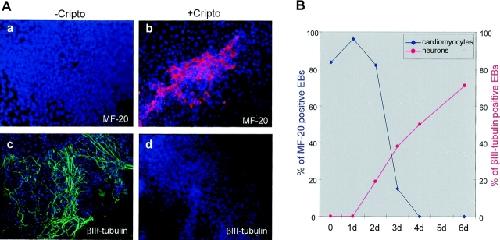XB-IMG-119184
Xenbase Image ID: 119184

|
|
Figure 5. Cripto promotes cardiomyocyte differentiation and inhibits neural differentiation of ES cells according to the timing of exposure. (A) Cardiomyocyte versus neuronal differentiation of Cripto−/− EBs as revealed by indirect immunofluorescence. 2-d-old Cripto−/− EBs, derived from DE7 cell line, were either left untreated (a and c) or treated for 24 h with 10 μg/ml of recombinant Cripto protein (b and d). On day 12 of in vitro differentiation, expression of either sarcomeric myosin or βIII-tubulin was revealed by immunofluorescence using anti–MF-20 (red, a and b) or βIII-tubulin (green, c and d) antibodies, respectively. Data are representative of at least two independent experiments. Comparable results were obtained with Cripto−/− DE14 ES cell line. (B) Cardiomyocyte versus neuronal differentiation of Cripto−/− EB–derived cells depends on the timing of exposure to Cripto. Percentage of Cripto−/− EBs stained for βIII-tubulin (red plot) or MF-20 (blue plot) after addition of recombinant Cripto protein at different time points. 10 μg/ml of recombinant Cripto protein was added to EBs at 24-h intervals starting from time 0 of the in vitro differentiation assay. On day 12 of in vitro differentiation, EBs were stained for either βIII-tubulin or MF-20 antibodies. Data are representative of two independent experiments. Image published in: Parisi S et al. (2003) Copyright © 2003, The Rockefeller University Press. This image is reproduced with permission of the journal and the copyright holder. This is an open-access article distributed under the terms of the Creative Commons Attribution-NonCommercial-ShareAlike license Larger Image Printer Friendly View |
